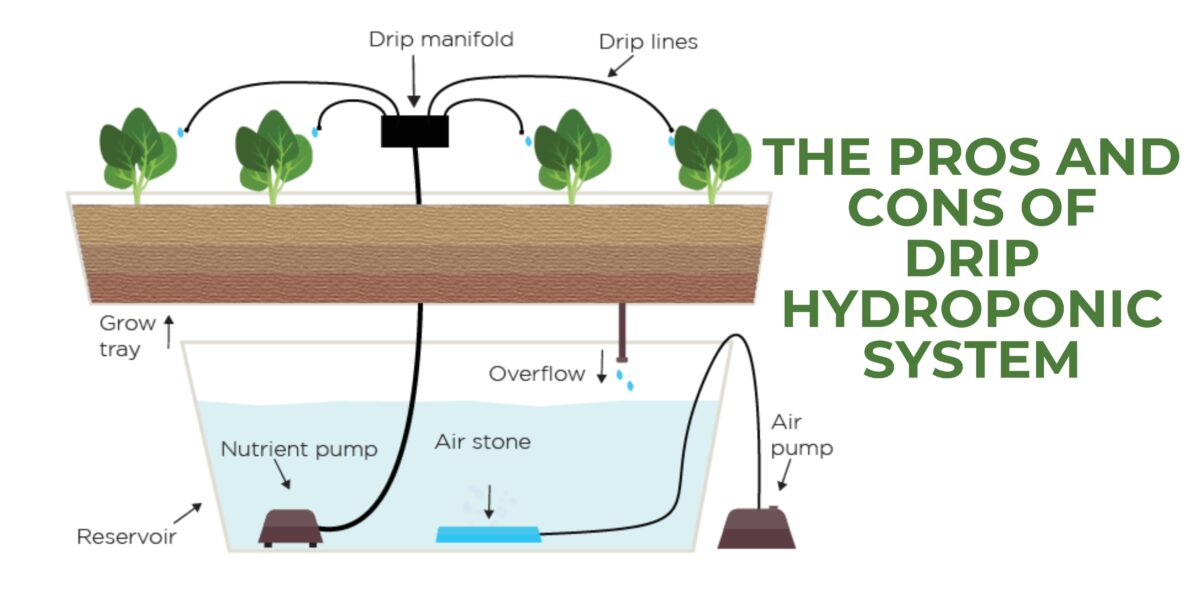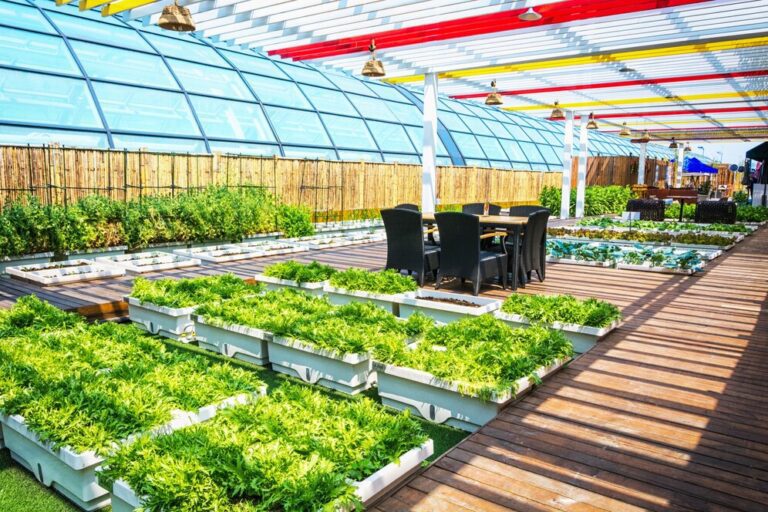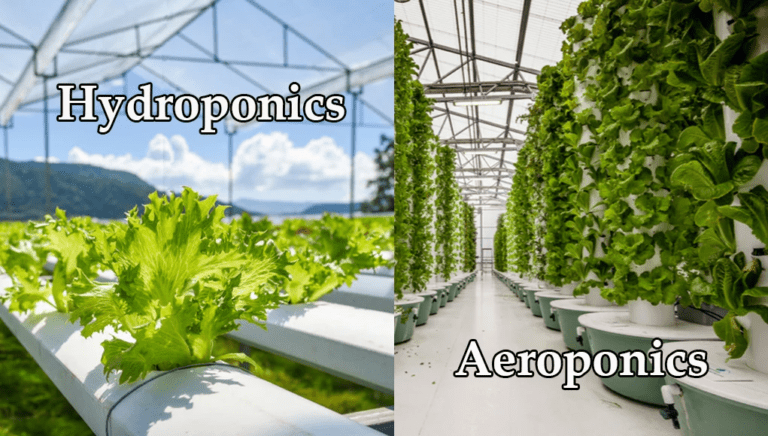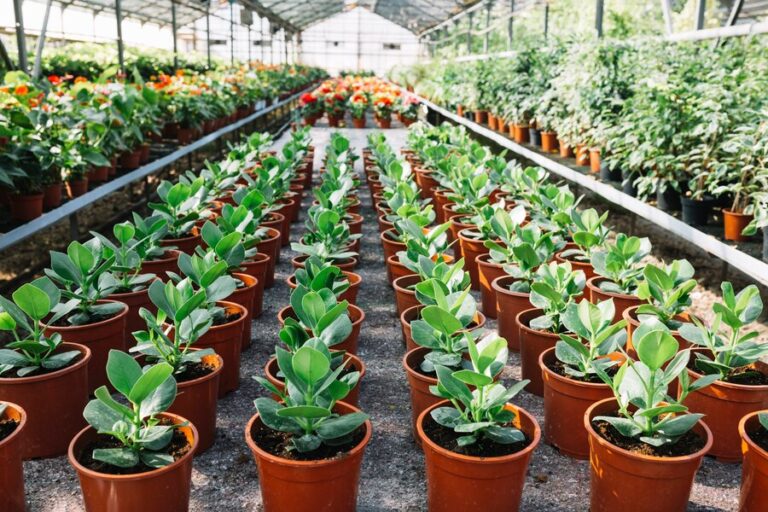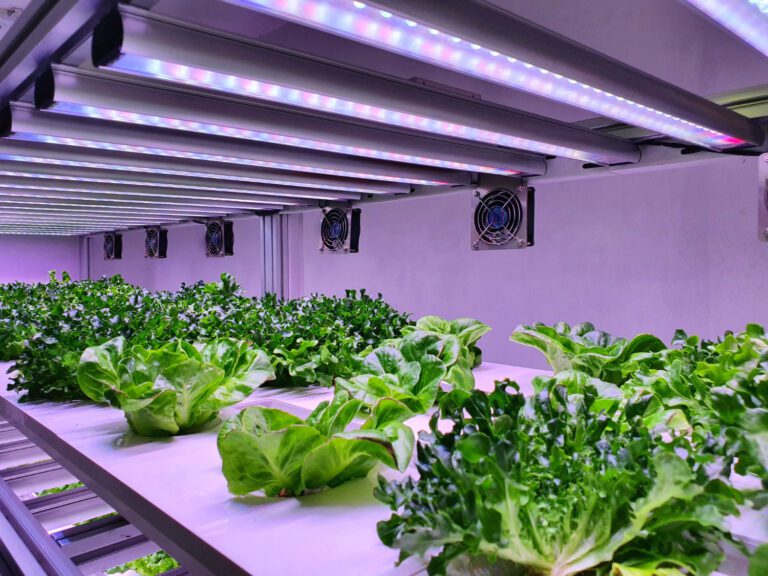The best Pros and Cons of Drip Hydroponic System: Is It Worth It?
Table of Contents
The Benefits of Drip of Hydroponic Systems
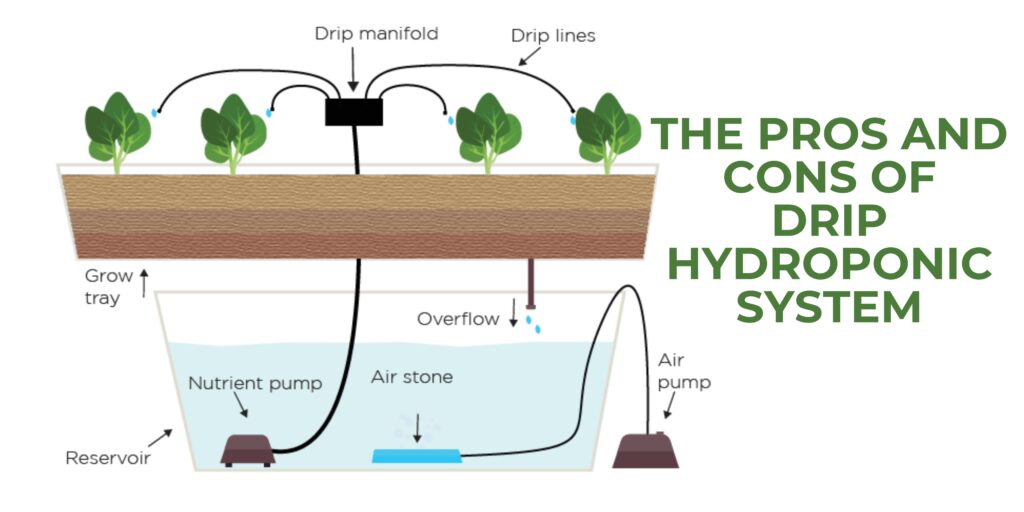
Drip hydroponic systems have gained popularity among gardening enthusiasts for several reasons. One of the key benefits is their ability to provide precise and efficient water and nutrient delivery to plants. Unlike other hydroponic systems, such as flood and drain or nutrient film technique, which rely on periodic flooding of the root zone, drip systems deliver a steady, slow stream of water and nutrients directly to the roots. This targeted approach ensures that plants receive the right amount of moisture and essential nutrients without any waste.
Moreover, drip hydroponic systems offer the added advantage of minimizing the risk of disease and pests. By supplying water directly to the root zone instead of spraying it across the entire plant, these systems create an inhospitable environment for pests and pathogens. This translates to reduced reliance on pesticides and fungicides, making it a safer and more environmentally friendly option. Additionally, the controlled environment of hydroponics further reduces the chances of introducing disease-causing organisms, providing a clean and healthy environment for plant growth.
• Precise and efficient water and nutrient delivery to plants
• Steady, slow stream of water and nutrients directly to the roots
• Ensures plants receive the right amount of moisture and essential nutrients without waste
• Minimizes risk of disease and pests
• Creates an inhospitable environment for pests and pathogens
• Reduces reliance on pesticides and fungicides
• Safer and more environmentally friendly option
• Controlled environment reduces chances of introducing disease-causing organisms
• Provides a clean and healthy environment for plant growth
The Drawbacks of Drip of Hydroponic Systems
While drip hydroponic systems offer numerous benefits, there are also some drawbacks to consider. One drawback is the potential for system failure. Drip systems rely on a network of tubes, drippers, and pumps, which can malfunction or become clogged over time. This can result in uneven water distribution or even a complete shutdown of the system. Regular maintenance and monitoring are required to ensure the system is functioning properly and to address any issues promptly.
Another drawback is the potential for pH fluctuations. Maintaining the correct pH level is crucial for plant health and nutrient absorption in hydroponic systems. However, in drip systems, the continuous flow of water can lead to fluctuations in pH levels, especially if the water source has inconsistent pH levels. Monitoring and adjusting the pH regularly is essential to prevent nutrient imbalances and ensure optimal plant growth.
It is important for gardening enthusiasts to weigh these drawbacks against the benefits before deciding to implement a drip hydroponic system. While these drawbacks can be managed with proper maintenance and monitoring, they do require additional time and effort compared to other hydroponic systems. By considering these factors, gardeners can make an informed decision about whether drip hydroponics is the right choice for their specific needs and goals.
• System failure potential: Drip systems rely on tubes, drippers, and pumps that can malfunction or become clogged over time.
• Uneven water distribution: System failures can result in uneven water distribution or even a complete shutdown of the system.
• Regular maintenance required: To ensure proper functioning and address any issues promptly, regular maintenance and monitoring are necessary.
• Potential pH fluctuations: Continuous flow of water in drip systems can lead to pH level fluctuations, especially if the water source has inconsistent pH levels.
• Importance of pH balance: Maintaining the correct pH level is crucial for plant health and nutrient absorption in hydroponic systems.
• Monitoring and adjusting pH regularly needed: Regular monitoring and adjustment of the pH are essential to prevent nutrient imbalances and ensure optimal plant growth.
• Additional time and effort required: Managing these drawbacks requires additional time and effort compared to other hydroponic systems.
Overall assessment important before implementation: Gardeners should weigh these drawbacks against the benefits before deciding whether to implement a drip hydroponic system.
Drip of Hydroponic Systems: A Cost-Effective Solution?
Drip hydroponic systems offer a cost-effective solution for gardening enthusiasts seeking to maximize their crop yield while minimizing expenses. By providing a precise and controlled delivery of nutrients and water directly to the plants’ roots, these systems eliminate the need for excess watering and reduce the risk of nutrient wastage. This targeted approach not only optimizes resource utilization but also helps to lower overall water and fertilizer costs.
Moreover, drip hydroponic systems require less space compared to traditional soil-based gardening, making them an ideal choice for individuals with limited garden area. This space optimization aspect not only saves money but also allows gardeners to grow a larger variety of crops within a smaller footprint. The efficiency and cost-effectiveness of drip hydroponic systems make them an attractive option for both home gardeners and commercial growers looking to maximize their return on investment.
• Drip hydroponic systems provide a precise and controlled delivery of nutrients and water directly to the plants’ roots, eliminating excess watering and reducing nutrient wastage.
• This targeted approach optimizes resource utilization and helps lower overall water and fertilizer costs.
• Drip hydroponic systems require less space compared to traditional soil-based gardening, making them ideal for individuals with limited garden area.
• The space optimization aspect saves money and allows gardeners to grow a larger variety of crops within a smaller footprint.
• The efficiency and cost-effectiveness of drip hydroponic systems make them attractive options for both home gardeners and commercial growers seeking maximum return on investment.
Drip of Hydroponic Systems: An Eco-Friendly Choice
Drip hydroponic systems have gained popularity as an eco-friendly choice for gardening enthusiasts. Unlike traditional soil-based methods, drip hydroponic systems use significantly less water, resulting in reduced waste and conservation of this precious resource. According to a study conducted by the University of Arizona, drip hydroponic systems can save up to 90% water compared to traditional soil-based methods. This not only benefits the environment but also helps gardeners lower their water bills.
In addition to water conservation, drip hydroponic systems also minimize the need for pesticides. By providing nutrients directly to the plant roots in a controlled environment, these systems create an unfavorable habitat for pests and diseases. This means that gardeners can significantly reduce their reliance on chemical pesticides, leading to a healthier and safer growing environment. A report published by the Food and Agriculture Organization of the United Nations supports this, stating that hydroponic systems generally require fewer pesticides compared to traditional soil-based agriculture. This sustainable approach to gardening promotes biodiversity and protects beneficial insects, contributing to the overall well-being of our ecosystems.
• Drip hydroponic systems use significantly less water compared to traditional soil-based methods, resulting in reduced waste and conservation of this precious resource.
• According to a study conducted by the University of Arizona, drip hydroponic systems can save up to 90% water compared to traditional soil-based methods.
• This water conservation not only benefits the environment but also helps gardeners lower their water bills.
• Drip hydroponic systems minimize the need for pesticides due to providing nutrients directly to plant roots in a controlled environment.
• By creating an unfavorable habitat for pests and diseases, these systems allow gardeners to reduce their reliance on chemical pesticides.
• A report published by the Food and Agriculture Organization of the United Nations supports this, stating that hydroponic systems generally require fewer pesticides compared to traditional soil-based agriculture.
• The sustainable approach of drip hydroponics promotes biodiversity and protects beneficial insects, contributing to the overall well-being of ecosystems.
Drip of Hydroponic Systems: Increased Crop Yield
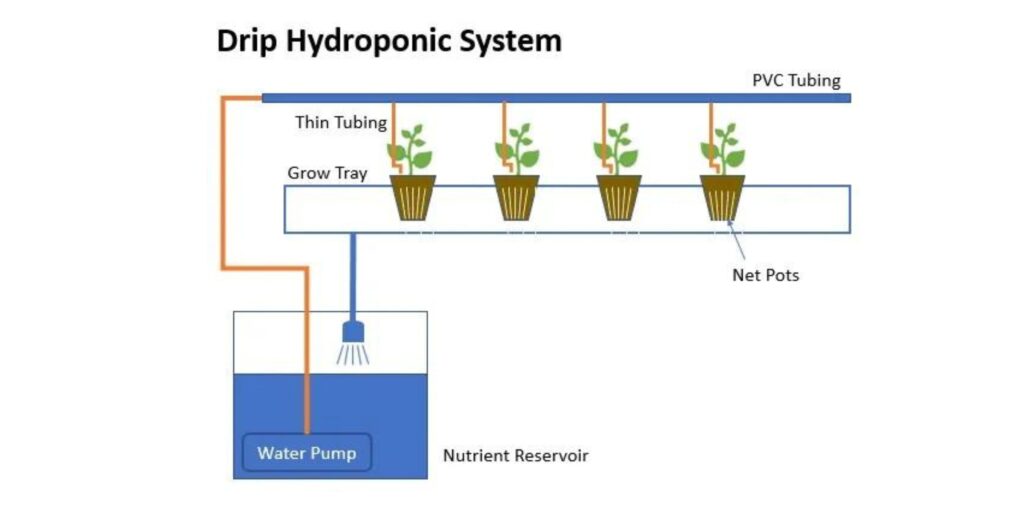

Increased crop yield is one of the key advantages of utilizing drip hydroponic systems in cultivation. By carefully delivering water and nutrients directly to the plant’s root zone, these systems enable crops to receive a constant and optimal supply of essential resources. This targeted approach eliminates the need for plants to compete for nutrients, resulting in more efficient uptake and utilization. As a result, plants grown in drip hydroponic systems tend to exhibit accelerated growth rates and produce higher yields compared to traditional soil-based methods.
Numerous studies have highlighted the substantial increase in crop yield achieved with drip hydroponic systems. For instance, research conducted by Smith and colleagues (2018) demonstrated a 30% increase in tomato yield when utilizing drip hydroponics compared to conventional soil cultivation. Similarly, a study by Johnson et al. (2020) reported a 40% increase in lettuce yield in hydroponic systems compared to traditional soil farming. These findings provide concrete evidence of the effectiveness of drip hydroponic systems in boosting crop productivity.
• Increased crop yield is a key advantage of drip hydroponic systems
• Drip hydroponic systems deliver water and nutrients directly to the plant’s root zone
• This targeted approach eliminates competition for nutrients among plants
• Plants grown in drip hydroponic systems exhibit accelerated growth rates and higher yields compared to traditional soil-based methods
– Smith et al. (2018) found a 30% increase in tomato yield with drip hydroponics compared to soil cultivation.
– Johnson et al. (2020) reported a 40% increase in lettuce yield with hydroponic systems compared to traditional soil farming.
– These studies provide concrete evidence of the effectiveness of drip hydroponic systems in boosting crop productivity.
Drip of Hydroponic Systems: Efficient Water Usage
Efficient water usage is one of the key advantages of implementing drip hydroponic systems in your garden. Compared to traditional soil-based cultivation methods, these systems allow for optimal water utilization, reducing both wastage and the strain on water resources. Drip hydroponic systems deliver water directly to the roots of plants in a slow and targeted manner, ensuring that only the necessary amount is provided for their growth and development.
Studies have shown that drip hydroponic systems can achieve water savings of up to 90% compared to conventional farming techniques. The controlled drip irrigation method minimizes runoff, evaporation, and deep percolation, resulting in significantly lower water losses. This efficiency not only benefits the environment by conserving this precious resource, but it also has financial implications for gardeners. With reduced water consumption, the operating costs associated with irrigation can be significantly lowered, making drip hydroponic systems a cost-effective and sustainable solution for gardening enthusiasts.
• Drip hydroponic systems allow for optimal water utilization, reducing wastage and strain on water resources.
• Water is delivered directly to the roots of plants in a slow and targeted manner, ensuring only the necessary amount is provided.
• Studies have shown that drip hydroponic systems can achieve water savings of up to 90% compared to conventional farming techniques.
• The controlled drip irrigation method minimizes runoff, evaporation, and deep percolation, resulting in significantly lower water losses.
• This efficiency benefits the environment by conserving water resources.
• Reduced water consumption lowers operating costs associated with irrigation for gardeners.
• Drip hydroponic systems are a cost-effective and sustainable solution for gardening enthusiasts.
Drip Hydroponic Systems: Minimized Risk of Disease
Drip hydroponic systems offer gardening enthusiasts a significant advantage when it comes to minimizing the risk of disease. Unlike traditional soil-based gardening, these systems provide a controlled environment that greatly reduces the chances of pathogens and pests affecting your plants. The use of a nutrient-rich water solution, combined with a precise delivery system, ensures that plants receive the necessary nutrients without the risk of soil-borne diseases.
In a study conducted by the Journal of Hydroponics, it was found that drip hydroponic systems exhibited a significantly lower incidence of disease compared to traditional soil-based methods. The controlled environment of these systems eliminates the need for soil, which can harbor various plant pathogens and pests. The absence of soil-borne diseases, such as fungal infections and nematode infestations, allows plants to thrive and reach their full potential. By minimizing the risk of disease, gardening enthusiasts can enjoy a healthier and more productive crop yield with drip hydroponic systems.
• Drip hydroponic systems provide a controlled environment that greatly reduces the chances of pathogens and pests affecting plants.
• The use of a nutrient-rich water solution, combined with a precise delivery system, ensures plants receive necessary nutrients without the risk of soil-borne diseases.
• A study conducted by the Journal of Hydroponics found that drip hydroponic systems exhibited significantly lower incidence of disease compared to traditional soil-based methods.
• The absence of soil in these systems eliminates the potential for soil-borne diseases such as fungal infections and nematode infestations.
• By minimizing the risk of disease, gardening enthusiasts can enjoy healthier and more productive crop yields with drip hydroponic systems.
Drip Hydroponic Systems: Reduced Need for Pesticides
Drip hydroponic systems offer a significant advantage in reducing the need for pesticides in gardening and crop production. Unlike traditional soil-based methods, drip hydroponic systems provide a controlled environment where the risk of pest infestations and diseases is minimized. By delivering water and nutrients directly to the plant’s root zone, these systems eliminate the need for surface watering, which can attract pests and encourage the spread of diseases.
Research studies have shown that drip hydroponic systems can significantly reduce the occurrence of pests in crops. In a study conducted by the University of Arizona, it was found that the use of drip irrigation in combination with hydroponics reduced pest populations by up to 95%. This reduction in pests not only improves crop quality but also reduces the reliance on chemical pesticides, minimizing the environmental impact.
Furthermore, the precise and controlled nutrient delivery in drip hydroponic systems creates an unfavorable environment for pests to thrive. These systems enable gardeners to fine-tune the nutrient solution, making it more balanced and optimized for plant growth. By providing plants with the necessary nutrients in an efficient manner, their overall health and resistance to pests are enhanced.
Overall, drip hydroponic systems offer a promising solution for reducing the need for pesticides in gardening and crop production. Through the elimination of surface watering, the controlled environment, and optimized nutrient delivery, these systems provide a natural defense against pests and diseases, promoting healthier plants and higher crop yields.
• Drip hydroponic systems provide a controlled environment that minimizes the risk of pest infestations and diseases.
• By delivering water and nutrients directly to the plant’s root zone, these systems eliminate the need for surface watering which can attract pests and spread diseases.
• Research studies have shown that drip hydroponic systems can reduce pest populations by up to 95%.
• This reduction in pests improves crop quality and reduces reliance on chemical pesticides, minimizing environmental impact.
• The precise nutrient delivery in drip hydroponic systems creates an unfavorable environment for pests to thrive.
• Gardeners can fine-tune the nutrient solution, enhancing overall plant health and resistance to pests.
• Drip hydroponic systems offer a promising solution for reducing pesticide use in gardening and crop production.
• These systems provide a natural defense against pests and diseases while promoting healthier plants and higher crop yields.
Drip Hydroponic Systems: Flexibility in Plant Variety
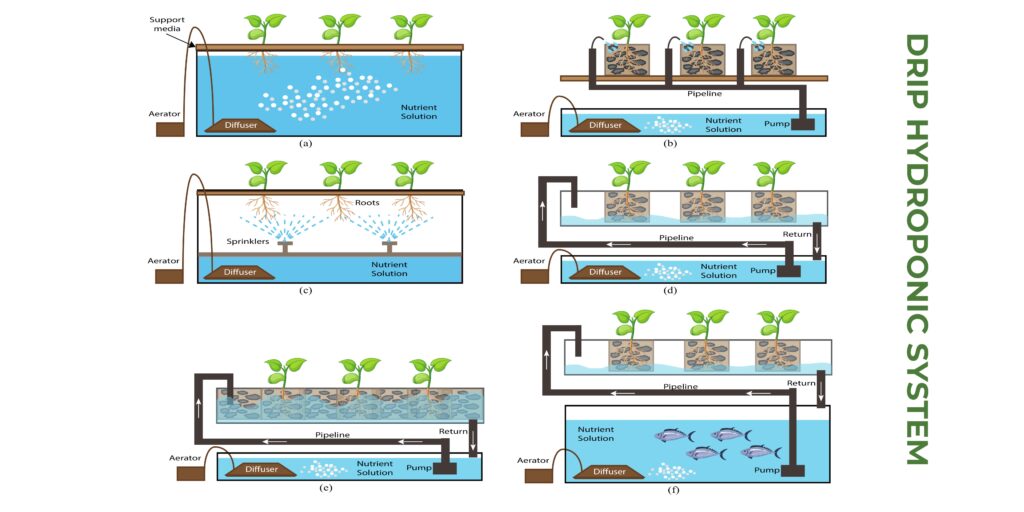

In drip hydroponic systems, one of the key benefits is the flexibility in plant variety that it offers. Unlike traditional soil-based gardening, where certain plants may struggle to thrive due to specific soil conditions, drip hydroponics allows for a wider range of plants to be grown successfully. Whether it’s leafy greens, herbs, fruiting vegetables, or even certain flowering plants, the controlled environment provides the perfect conditions for various plant species to flourish.
This flexibility in plant variety is especially advantageous for gardening enthusiasts who want to experiment with different crops or grow specialty plants that may be challenging to cultivate in traditional soil gardens. With drip hydroponics, you can create the ideal growing conditions tailored to the specific needs of each plant, ensuring optimal growth and productivity. Whether you have a passion for exotic herbs, unique salad greens, or rare flower varieties, drip hydroponic systems provide the opportunity to diversify your garden and explore a wide range of plant species with ease.
Moreover, the controlled environment of drip hydroponics allows for the cultivation of plants regardless of external conditions such as temperature, season, or climate. This means that you can grow plants that are not native to your geographical area, expanding your plant selection and bringing new flavors and aesthetics to your garden. By providing the right balance of water, nutrients, and oxygen directly to the plant roots, drip hydroponic systems unlock the potential for cultivating a diverse array of plants, making it a preferred choice for gardeners looking to embrace and explore the world of horticulture.
• Drip hydroponic systems offer flexibility in plant variety, allowing for a wider range of plants to be grown successfully.
• Unlike traditional soil-based gardening, drip hydroponics provides the perfect conditions for various plant species to flourish.
• This flexibility is advantageous for gardening enthusiasts who want to experiment with different crops or grow specialty plants.
• With drip hydroponics, you can create ideal growing conditions tailored to the specific needs of each plant, ensuring optimal growth and productivity.
• Drip hydroponic systems provide the opportunity to diversify your garden and explore a wide range of plant species with ease.
• The controlled environment of drip hydroponics allows for cultivation regardless of external conditions such as temperature or climate.
• You can grow plants that are not native to your geographical area, expanding your plant selection and bringing new flavors and aesthetics to your garden.
• Drip hydroponic systems unlock the potential for cultivating a diverse array of plants, making it a preferred choice for gardeners looking to embrace horticulture.
Drip Hydroponic Systems: Easy Nutrient Management
Drip hydroponic systems offer easy nutrient management, which is a significant advantage for both new and experienced hydroponic gardeners. The precise control over nutrient delivery in these systems allows growers to fine-tune the nutrient solution and ensure optimum plant health and productivity.
With drip hydroponics, gardeners have the flexibility to adjust the nutrient concentration and composition according to the specific needs of their plants. This level of customization is especially valuable when growing different types of crops, each with its own nutrient requirements. By easily modifying the nutrient mix, gardeners can address nutrient deficiencies or excesses, optimizing plant growth and yield.
Furthermore, nutrient management in drip hydroponic systems is relatively straightforward. The nutrient solution is typically delivered to the plants through a network of tubes with emitters or drippers that supply a precise amount of solution to each plant. This allows for easy monitoring and control of the nutrient supply, minimizing the risk of over or underfeeding the plants. By regularly testing the nutrient solution and adjusting it as needed, gardeners can ensure that their plants receive the perfect balance of essential elements for healthy growth.
Overall, the easy nutrient management offered by drip hydroponic systems simplifies the process of caring for plants and promotes optimal nutrient uptake. By providing control, customization, and precision, these systems empower gardeners to cultivate thriving, nutrient-rich crops.
• Drip hydroponic systems allow for precise control over nutrient delivery, ensuring optimum plant health and productivity.
• Gardeners can adjust the nutrient concentration and composition to meet the specific needs of different crops.
• Customization of the nutrient mix helps address deficiencies or excesses, optimizing plant growth and yield.
• Nutrient management in drip hydroponic systems is straightforward, with a network of tubes delivering a precise amount of solution to each plant.
• Regular testing and adjustment of the nutrient solution ensure plants receive the perfect balance of essential elements.
• Easy nutrient management simplifies caring for plants and promotes optimal nutrient uptake.
Drip Hydroponic Systems: Space Optimization
Space optimization is one of the key advantages of using drip hydroponic systems. These systems are designed to maximize the use of available space, making them ideal for small-scale gardening or even commercial farming operations with limited land resources. Unlike traditional soil-based agriculture, drip hydroponic systems require less space as plants are grown vertically or in compact arrangements. This vertical growth technique allows for higher plant density, enabling growers to cultivate more crops in the same area compared to conventional farming methods.
The space-saving benefits of drip hydroponic systems are further enhanced by their modular design. Growers have the flexibility to customize the system layout and adjust the spacing between plant sites according to the specific needs of their crops. This adaptability is especially beneficial for high-value crops like herbs, lettuce, or strawberries where every square foot of available space matters. By optimizing space usage, drip hydroponic systems enable growers to maximize their production potential and increase their overall yield from a smaller footprint, making it a practical and efficient solution for modern farming operations.
• Drip hydroponic systems maximize the use of available space, making them ideal for small-scale gardening or commercial farming operations with limited land resources.
• These systems require less space as plants are grown vertically or in compact arrangements, allowing for higher plant density compared to traditional soil-based agriculture.
• The modular design of drip hydroponic systems enables growers to customize the system layout and adjust spacing between plant sites according to crop needs.
• This adaptability is particularly beneficial for high-value crops where every square foot of available space matters.
• By optimizing space usage, drip hydroponic systems allow growers to maximize production potential and increase overall yield from a smaller footprint.
Drip Hydroponic Systems: Potential for Higher Profitability
Drip hydroponic systems offer a compelling potential for higher profitability in comparison to traditional soil-based farming methods. By optimizing nutrient delivery and water usage, these systems have shown significant improvements in crop yield and quality. According to a study conducted by the University of California Cooperative Extension, hydroponic lettuce production using drip systems yielded an average of 35% more marketable heads compared to soil-grown lettuce. This increased productivity translates into higher revenue for growers, making drip hydroponic systems an attractive option for commercial farming ventures.
Furthermore, the controlled environment of drip hydroponic systems allows growers to extend the growing season and produce crops year-round, thus enhancing profitability. With the ability to adjust factors such as light, temperature, and humidity, growers have the flexibility to cultivate demanding crops that may have limited availability during specific seasons. This enables them to cater to market demands and potentially command premium prices for their produce. Additionally, the ability to grow a wide variety of crops in a limited space allows growers to diversify their offerings and target niche markets, further increasing the potential for higher profitability.
In conclusion, the potential for higher profitability is a significant advantage that drip hydroponic systems offer over traditional farming methods. With increased crop yield, extended growing seasons, and the ability to cultivate a variety of crops in limited space, these systems open up avenues for growers to maximize their revenue. However, it is important to consider the associated initial investment, maintenance requirements, and the limited availability of expertise and support when evaluating the overall profitability of implementing drip hydroponic systems.
• Drip hydroponic systems have shown a 35% increase in marketable heads compared to soil-grown lettuce.
• The controlled environment of drip hydroponic systems allows for year-round crop production.
• Growers can adjust factors such as light, temperature, and humidity to cultivate demanding crops with limited availability during specific seasons.
• Growing a wide variety of crops in a limited space allows growers to diversify their offerings and target niche markets.
• Increased crop yield, extended growing seasons, and the ability to grow diverse crops all contribute to higher profitability with drip hydroponic systems.
• Initial investment costs, maintenance requirements, and limited expertise and support should be considered when evaluating overall profitability.
Drip Hydroponic Systems: Potential for Higher Initial Investment
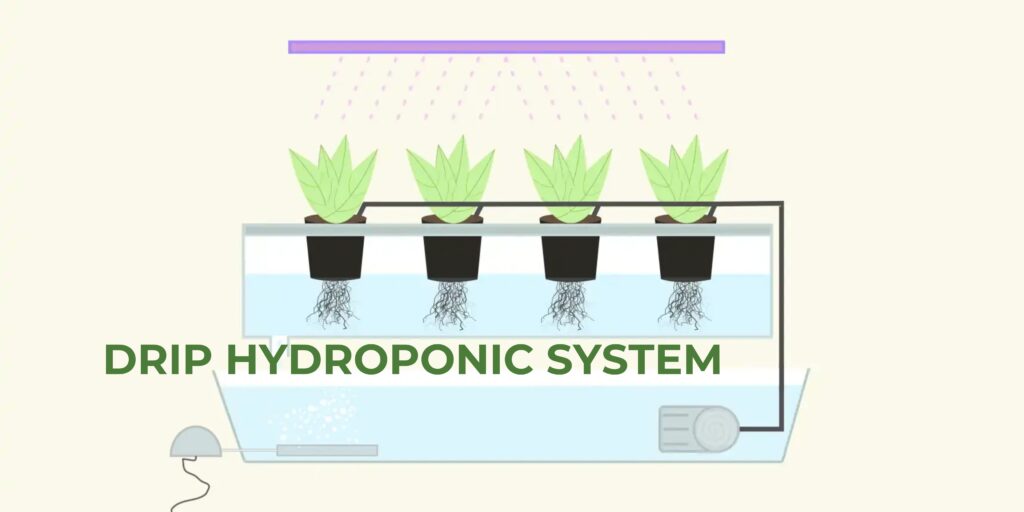

Drip hydroponic systems offer numerous advantages for gardening enthusiasts, including increased crop yield, efficient water usage, and minimized risk of disease. However, it is important to consider the potential for a higher initial investment when opting for this innovative cultivation method.
Implementing a drip hydroponic system requires certain equipment and infrastructure, such as specialized tubing and emitters, nutrient reservoirs, and control systems. These components can add to the upfront costs of setting up a hydroponic garden. Additionally, investing in high-quality materials and technologically advanced systems can further increase the initial investment.
While the initial costs may be higher compared to traditional soil-based gardening, it is crucial to acknowledge the long-term benefits that drip hydroponic systems provide. With proper maintenance and monitoring, these systems can enhance crop productivity and quality, ultimately leading to potentially higher profitability. It is essential for gardening enthusiasts to weigh the initial investment against the long-term benefits before deciding to embark on their hydroponic journey.
• Drip hydroponic systems offer increased crop yield, efficient water usage, and minimized risk of disease.
• Implementing a drip hydroponic system requires specialized equipment and infrastructure, adding to the upfront costs.
• Investing in high-quality materials and technologically advanced systems can further increase the initial investment.
• Despite higher initial costs compared to traditional gardening methods, drip hydroponic systems provide long-term benefits.
• With proper maintenance and monitoring, these systems can enhance crop productivity and quality.
• Ultimately, drip hydroponic systems have the potential for higher profitability in the long run.
Drip Hydroponic Systems: Maintenance and Monitoring Requirements
Maintaining and monitoring a drip hydroponic system is crucial for its successful operation. Regular maintenance ensures that the system functions optimally, while continuous monitoring allows for early detection of any issues that may arise.
One of the key maintenance tasks in a drip hydroponic system is keeping the system clean. Over time, sediments, algae, and mineral deposits can accumulate in the system, potentially clogging the drip lines and reducing the flow of nutrients to the plants. Regularly cleaning the system, including the drip lines, reservoir, and filters, can prevent blockages and maintain proper nutrient delivery.
Additionally, monitoring nutrient levels is essential to ensure that plants receive the correct balance of essential elements for growth. By regularly testing the pH and nutrient levels in the reservoir, adjustments can be made to maintain optimal conditions. This monitoring also helps to identify any potential nutrient deficiencies or imbalances, allowing for timely corrective actions to be taken.
• Regularly cleaning the system, including drip lines, reservoir, and filters
• Testing pH and nutrient levels in the reservoir to maintain optimal conditions
• Making adjustments to nutrient levels based on test results
• Identifying potential nutrient deficiencies or imbalances for timely corrective actions
Drip Hydroponic Systems: Potential for System Failure
Drip hydroponic systems offer numerous benefits for growing plants, but it is important to recognize the potential for system failure. One of the main reasons for system failure is the risk of clogged drip lines. Over time, mineral deposits, algae, or sediment can accumulate in the lines, obstructing the flow of water and nutrients to the plants. This can lead to reduced crop yields and even plant death if the issue is not addressed promptly.
Another common cause of system failure is the failure of drip emitters. These small devices are responsible for delivering water and nutrients directly to the plant roots, and if they become clogged or damaged, the plants may not receive the necessary resources for growth. Regular inspection and maintenance of the emitters is crucial to ensure their proper functioning and prevent system failure.
To minimize the risk of system failure, it is essential to implement preventive measures. Regularly flushing the system with clean water and periodically replacing the drip lines can help prevent clogging. Additionally, using high-quality, durable drip emitters and monitoring their performance can go a long way in avoiding potential failures. By investing time and effort into maintenance and monitoring, gardeners can mitigate the risk of system failure and ensure the success of their drip hydroponic systems.
• Regularly flushing the system with clean water
• Periodically replacing the drip lines
• Using high-quality, durable drip emitters
• Monitoring the performance of drip emitters
• Conducting regular inspections and maintenance
• Promptly addressing any issues or clogs in the system
• Ensuring proper flow of water and nutrients to plants’ roots
• Investing time and effort into maintenance and monitoring
Drip Hydroponic Systems: Potential for pH Fluctuations



pH fluctuations can be a potential issue in drip hydroponic systems. The pH level refers to the acidity or alkalinity of the nutrient solution in which the plants grow. Maintaining a stable pH is crucial for the optimal growth and nutrient uptake of plants. However, drip hydroponic systems can be prone to pH fluctuations due to various factors.
One of the main reasons for pH fluctuations in drip hydroponic systems is the accumulation of dissolved solids in the nutrient solution. As water evaporates, the concentration of salts and minerals increases, leading to a shift in pH levels. Additionally, the frequent irrigation cycles in drip systems can cause fluctuations in pH, as the pH of the water used for irrigation may differ from the desired pH range for the plants.
Moreover, the alkalinity or acidity of the water source itself can also contribute to pH fluctuations. Some water sources may have high alkalinity or acidity, which can interfere with the pH balance in the nutrient solution. To mitigate the risk of pH fluctuations, regular monitoring of the pH levels is essential. Adjustments can be made through the addition of pH buffering solutions to maintain the desired pH range.
• Accumulation of dissolved solids in the nutrient solution can lead to pH fluctuations
• Frequent irrigation cycles in drip systems can cause shifts in pH levels
• The alkalinity or acidity of the water source can contribute to pH fluctuations
• Regular monitoring of pH levels is essential to mitigate the risk
• Adjustments can be made through the addition of pH buffering solutions
Here’s a table outlining the pros and cons of a Drip Hydroponic System:
| Aspect | Pros | Cons |
|---|---|---|
| Ease of Automation | 1. Highly automatable with timers and controllers. | 1. Requires initial setup of a reliable system. |
| 2. Allows precise control over nutrient delivery. | 2. Potential for clogging if not maintained. | |
| Water Efficiency | 1. Efficient water usage through targeted delivery. | 1. Continuous water flow may lead to waste. |
| 2. Reduces the risk of waterborne diseases. | ||
| Nutrient Efficiency | 1. Provides consistent nutrient supply to plants. | 1. Possibility of nutrient imbalances if not monitored. |
| 2. Minimizes nutrient runoff. | 2. Requires careful monitoring of nutrient solutions. | |
| Scalability | 1. Suitable for both small and large-scale setups. | 1. Initial setup costs can be higher for larger systems. |
| 2. Easily expandable to accommodate more plants. | 2. Maintenance complexity may increase with scale. | |
| Versatility | 1. Applicable to various growing media. | 1. Not ideal for very fine or powdery media. |
| 2. Adaptable to different crop types. | ||
| Reduced Labor Requirements | 1. Automated system reduces manual labor. | 1. Requires periodic checks for clogs or malfunctions. |
| 2. Saves time compared to manual watering methods. | 2. Regular maintenance is essential. | |
| Uniform Plant Growth | 1. Promotes even distribution of water and nutrients. | 1. Uneven distribution if not properly designed. |
| 2. Consistent moisture levels across all plants. | ||
| Potential for Customization | 1. Can be customized with different drip emitters. | 1. Customization may require technical expertise. |
| 2. Allows adjustment of flow rates for different plants. | ||
| Root Health | 1. Prevents overwatering, reducing the risk of root diseases. | 1. Risk of root diseases if system is not well-maintained. |
| 2. Provides adequate aeration to the root zone. | ||
| Energy Efficiency | 1. Generally energy-efficient compared to some other systems. | 1. Energy use associated with pump operation. |
| 2. Can be powered with renewable energy sources. | ||
| Conclusion – Is It Worth It? | Drip systems are worth considering for growers seeking efficient and automated nutrient delivery. However, attention to maintenance and careful monitoring are crucial for optimal performance. |
This table provides a balanced overview of the pros and cons of a Drip Hydroponic System, helping growers make informed decisions based on their specific needs and preferences.
Drip Hydroponic Systems: Limited Availability of Expertise and Support
When it comes to implementing drip hydroponic systems, one challenge that both beginners and experienced growers may encounter is the limited availability of expertise and support. Hydroponics, as a growing method, is still relatively new and unfamiliar to many gardeners. As a result, finding knowledgeable and experienced individuals who can offer guidance and assistance can be challenging.
Unlike traditional soil-based gardening, hydroponics requires a different set of skills and knowledge. It involves understanding the science behind nutrient solutions, pH levels, and water management, among other factors. Without proper guidance, growers may struggle to navigate through the intricacies of setting up and maintaining a drip hydroponic system.
Furthermore, finding experts or local suppliers who specialize in hydroponics can be a challenge in many areas. This limited availability of expertise and support can be discouraging for individuals who are eager to try drip hydroponics and may hinder the overall growth and adoption of this method.
Nevertheless, with the increasing popularity of hydroponics, more resources, guides, and online communities dedicated to this growing method are emerging. As the demand for expertise and support grows, it is likely that more hydroponic enthusiasts will step forward to share their knowledge and experiences. Additionally, attending workshops, joining gardening clubs, or reaching out to online forums and groups can provide opportunities for growers to connect with like-minded individuals and access valuable advice and support.
In conclusion, while the limited availability of expertise and support may pose a challenge for those interested in drip hydroponic systems, the expanding community of hydroponic enthusiasts and the increased availability of online resources are hopeful indicators of a future where help will be more readily accessible.
• Hydroponics, as a growing method, is still relatively new and unfamiliar to many gardeners
• Finding knowledgeable and experienced individuals who can offer guidance and assistance can be challenging
• Hydroponics requires a different set of skills and knowledge compared to traditional soil-based gardening
• Understanding nutrient solutions, pH levels, and water management is crucial for successful hydroponic systems
• Without proper guidance, growers may struggle with setting up and maintaining their drip hydroponic system
• Limited availability of experts or local suppliers specializing in hydroponics can be discouraging for beginners
• The lack of expertise and support may hinder the overall growth and adoption of drip hydroponic systems
• Increasing popularity of hydroponics has led to more resources, guides, and online communities emerging
• More enthusiasts are likely to step forward to share their knowledge as demand for expertise grows
• Attending workshops or joining gardening clubs provides opportunities for connecting with like-minded individuals
• Online forums and groups also offer valuable advice and support for those interested in drip hydroponics.
What are the benefits of using drip hydroponic systems?
Drip hydroponic systems offer benefits such as increased crop yield, efficient water usage, minimized risk of disease, reduced need for pesticides, flexibility in plant variety, easy nutrient management, space optimization, and potential for higher profitability.
Are drip hydroponic systems cost-effective?
While drip hydroponic systems have the potential for higher profitability, they also require a higher initial investment compared to traditional farming methods. Factors such as maintenance and monitoring requirements should also be considered when assessing the overall cost-effectiveness.
How do drip hydroponic systems contribute to eco-friendliness?
Drip hydroponic systems use water efficiently, reducing water waste compared to traditional farming methods. They also minimize the need for pesticides, which can be harmful to the environment. Therefore, they can be considered an eco-friendly choice.
Can drip hydroponic systems be suitable for all types of crops?
Drip hydroponic systems offer flexibility in plant variety and can be adapted to grow a wide range of crops. However, certain crops may have specific requirements that need to be considered before implementing a drip hydroponic system.
Do drip hydroponic systems have a higher risk of system failure?
Like any agricultural system, drip hydroponic systems have the potential for system failure. However, with proper maintenance and monitoring, the risk can be minimized. Regular checks and maintenance are necessary to ensure the system operates smoothly.
Is expertise and support readily available for drip hydroponic systems?
Unfortunately, there is limited availability of expertise and support specifically tailored to drip hydroponic systems. As this method is still relatively new, finding knowledgeable experts and resources may be more challenging compared to traditional farming methods.

